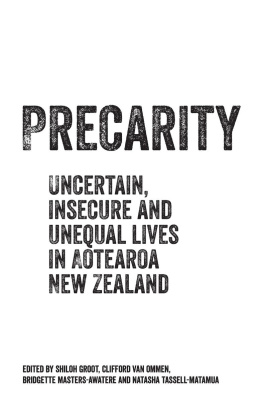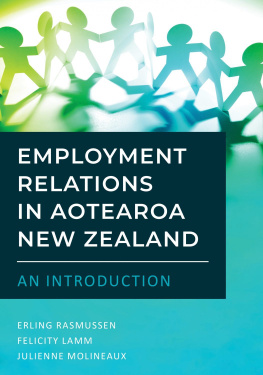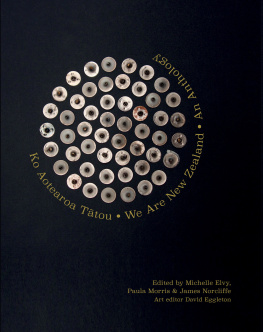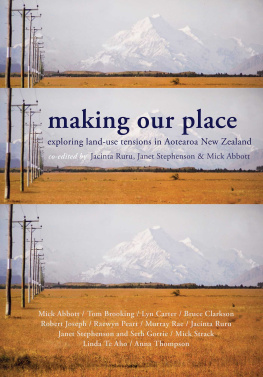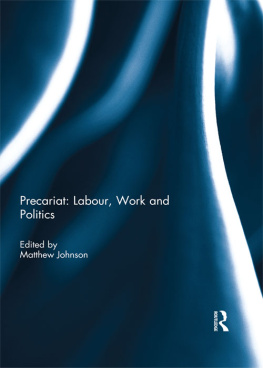Leading British economist Guy Standing has referred to the precariat as a class-in-the-making. The precariat are our fellow citizens be they poor, elderly, disabled, homeless, estranged from their cultural communities, refugees, engaged in casual work who lead lives of uncertainty, dependency, powerlessness, perilousness and insufficiency. They are the outcome of the gradual dismantling of the welfare state and the withering of union representation. They are also the victims of the changing nature of work.
This important book moves beyond the world of labour to identify and illustrate other forms of precarity in New Zealand, including the lack of opportunities for cultural expression and the struggle to be safe. It focuses on New Zealands emerging class not to further vilify it but rather to place its members lived experience in plain sight. As the editors say, It is time that all New Zealanders understood the reality of what many of our citizens endure in the struggle to make ends meet and live dignified lives.
CONTENTS
- FOREWORD
Guy Standing - INTRODUCTION
Clifford van Ommen, Shiloh Groot, Bridgette Masters-Awatere and Natasha Tassell-Matamua - PART 1:
SELLING SNAKE OIL - INTRODUCTION
Clifford van Ommen and Shiloh Groot - 1:1
A STATISTICAL PORTRAIT OF THE NEW ZEALAND PRECARIAT
William Cochrane, Thomas Stubbs, Mohi Rua and Darrin Hodgetts - 1:2
FROM WORKING POVERTY TO SUSTAINABLE LIVELIHOOD: WHAT CAN APPLIED PSYCHOLOGY OFFER?
James Arrowsmith, Stuart C. Carr, Jarrod Haar, Harvey Jones, Jane Parker and Christian Yao - 1:3
MEDIA DEPICTIONS OF PRECARIOUS WORK WITHIN NEOLIBERAL CAPITALISM: THE NEW ZEALAND EXPERIENCE
Wayne Hope and Jane Scott - 1:4
PENAL WELFARE: WHAT IT DOES, AND WHY WE SHOULD CHANGE IT
Darrin Hodgetts, Ottilie Stolte, Kerry Chamberlain and Shiloh Groot - 1:5
WHEN DOLLAR LOAVES ARE ALL YOU HAVE: EXPERIENCES OF FOOD INSECURITY IN HAMILTON, NEW ZEALAND
Kimberly Jackson and Rebekah Graham - 1:6
OUT OF THE PAN INTO THE FIRE: PRECARIOUSNESS AMONG WOMEN AND CHILDREN ESCAPING DOMESTIC VIOLENCE
Neville Robertson and Bridgette Masters-Awatere - 1:7
OLDER PEOPLE, INEQUALITIES AND THE LESSONS OF UNIVERSALITY
Mary Breheny - PART 2:
NATIVE DISRUPTION MORI AND THE PRECARIAT - INTRODUCTION
Bridgette Masters-Awatere and Natasha Tassell-Matamua - 2:8
THE MORI PRECARIAT: A SILHOUETTE
Thomas Stubbs, William Cochrane, Lynley Uerata, Darrin Hodgetts and Mohi Rua - 2:9
HOW MORI PRECARIAT FAMILIES NAVIGATE SOCIAL SERVICES
Delta King, Mohi Rua and Darrin Hodgetts - 2:10
REPRODUCING THE PRECARIOUS POSITION OF YOUNG MORI MOTHERS IN AOTEAROA NEW ZEALAND
Felicity Ware, Mary Breheny and Margaret Forster - 2:11
A GAME OF SLIDES AND LADDERS: MORI HEALTH PROVIDERS AND FUNDERS
Bridgette Masters-Awatere - 2:12
IM TANGATA WHENUA, AND IM STILL HERE: MORI YOUTH HOMELESSNESS
Shiloh Groot, Tycho Vandenburg and Darrin Hodgetts - PART 3:
ARRIVALS PAST AND PRESENT - INTRODUCTION
Shiloh Groot and Clifford van Ommen - 3:13
CAN I HAVE A DECENT JOB? THE LABOUR MARKET EXPERIENCES OF NON-EUROPEAN IMMIGRANTS
Paul Spoonley - 3:14
CROSSROADS: EXPERIENCING SAMOAN BEREAVEMENT PARADIGMS AS AN AFAKASI SAMOAN
Byron Malaela Sotiata Seiuli and Philip Siataga - 3:15
PASIFIKA WOMEN AFFECTED BY DOMESTIC VIOLENCE: THE CASE OF TEUILA
Bridgette Masters-Awatere and Jessica Gosche - 3:16
OCCUPATIONAL JUSTICE: SAMOAN TRANS(GENDER) WOMEN
Seraphine Williams and Shiloh Groot - 3:17
PRECARIOUS REFUGE: A CONVERSATION WITH ABANN KAMYAY AJAK YOR
Sarah Hahn - 3:18
PERFORMING THE PRECARIAT: ACTING FOR ASYLUM SEEKERS AND REFUGEES IN AOTEAROA NEW ZEALAND
Rand Hazou - CONCLUSION: TOWARDS BUILDING AN EQUITABLE SOCIETY
Shiloh Groot, Bridgette Masters-Awatere, Clifford van Ommen and Natasha Tassell-Matamua
T he precariat is a structural feature of globalisation and is growing in all parts of the world, reflecting the impact of policies to make labour markets more flexible and open, and the impact of the ongoing technological revolution.
Governments, including New Zealands, have pursued social policies that have further expanded the precariat, in the ostensible pursuit of competitiveness. But they have done so in an inequitable way, by making labour relationships more insecure and uncertain. In sum, the precariat is not an incidental feature, or some failing of economic development. It is wanted by those steering and gaining from a global system that has veered a long way from anything close to a textbook version of a free market economy.
As described elsewhere, the reality is that we have a system best described as rentier capitalism, in which private property rights have triumphed over free market principles. That economic reality is outside the sphere of this book, but it is the context in which those entering or stuck in the precariat exist, and explains why their incomes are stagnant in real terms and increasingly uncertain.
There is an ongoing Global Transformation, in which a global market system is gradually taking shape. Old systems of regulation, social protection and income distribution that worked reasonably well in the middle decades of the twentieth century have broken down or been dismantled. But new systems suited to the more open, flexible economies have not yet been designed or put in place.
They are needed as a matter of urgency. A class fragmentation is taking shape that is forcing the precariat to hear a disproportionate cost in terms of disruption and multiple insecurities. So far, governments have reacted passively and have done remarkably little to alleviate those insecurities, typically resorting to tired strategies designed in a different age.
The precariat is defined primarily in four dimensions, and it is analytically and politically important to recognise all of them, not just the first and most obvious, the insecure labour relationship. Indeed, one could say that is the least important. Why would anybody want to be in a stable, secure job if it was stultifying, onerous, stressful and low-paid? And most of us would hate ourselves if we were stuck in the same job, doing the same few tasks, for years and years.
What is more important and worrying is that those in the precariat typically have no occupational narrative or identity. They feel they are going nowhere in their jobs. And they typically must do a great deal of work that is not labour, work that is neither recognised statistically nor remunerated in any way, but which must be done.
The second feature is that, in most countries, although less so in New Zealand, members of the precariat have to rely mainly if not entirely on wages. They do not receive the sort of non-wage benefits and subsidised services that members of the salariat usually receive, which are worth a great deal, such as occupational pensions in prospect, paid holidays and paid sick leave. In New Zealand, the Kiwisaver scheme at least offers a universal occupational pension for those who can pay into it.
In any case, conventional income statistics underplay the value of non-wage benefits and thus understate the extent of income inequality. But to make matters substantially worse, the wages available to the precariat are not just low but have been stagnant or declining. This is a global phenomenon, and policymakers and those representing the interests of the precariat must recognise that this is unlikely to change in OECD countries for years to come. Wages are likely to fall in real value.

